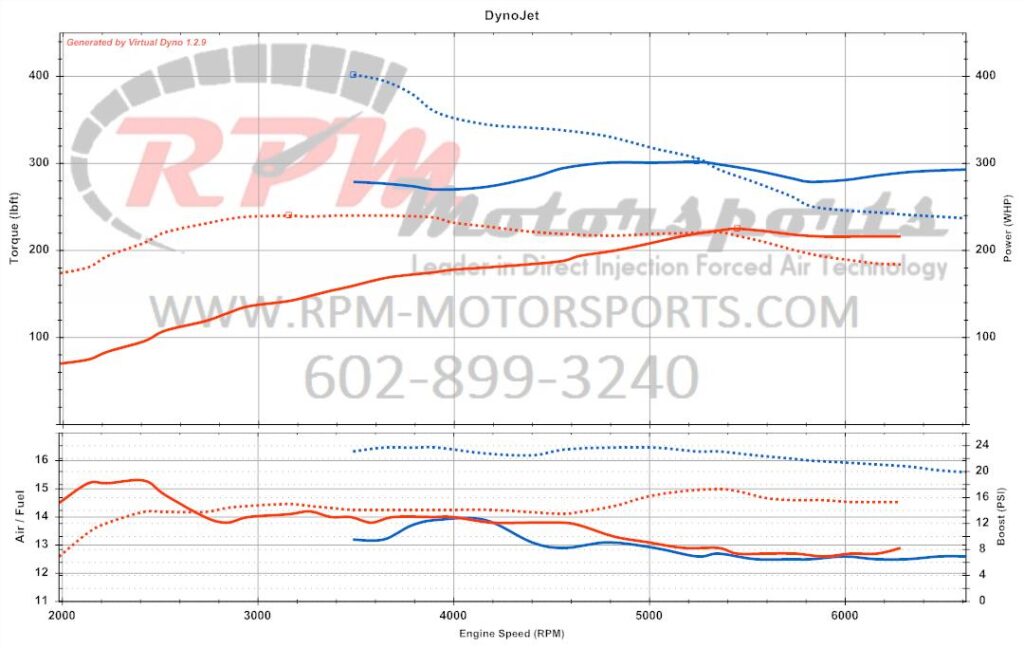We recently sent out some of our V-Tuner kits to customers across the country who purchased the Stage 2 Kits from our online store. Instead of having the customer mail us their ECU and wait until they get the new ECU back to drive it again, our process does not involve ANY downtime.
From the moment the package arrives at your door, we are capable of walking you through the easy setup of the V-Tuner system, which needs nothing more than a Wifi connection, some power, and to be plugged into your OBDII Port under the steering wheel.
From there, we set you up for some initial data logging. Unlike “canned tunes” that are prepared by most speed shops or mail order tuning companies, our process does not even begin until after we have looked over your current file and have you make two 10-minute data logging sessions. All you need to do is drive like you normally do for the first log, and for the second log we ask for some full throttle pulls. This allows us to see your car’s current behavior during the broadest spectrum of driving environments. Best of all, unlike dyno machines where your car just free spins some rollers in a garage, our process captures data on the open road, in real world conditions. Vehicle weight, wind resistance, and uphill/downhill driving conditions are taken into account to insure the closest thing to real life scenarios, because you are driving in your real world environment.
After the data logs have been captured, our in-house tuner can write your Stage 1 or Stage 2 file and add in the data captured from your car’s sensors. We make adjustments to airflow calculations, timing tables, fuel mapping, boost control, torque management and more based upon what we see in the logs. This process gives each one of our customers a custom tune, as well as Before and After dyno results.

After uploading the base calibration for the Stage 1 or Stage 2 file to the car, additional datalogs are captured of the tune in action. We still recommend one log to consist of at least 10 minutes of around town driving, without any full throttle activity, and the second log to contain a good number of 3rd gear full throttle pulls.
These two varied logs allow us to further calibrate the tune to the car’s modifications and the sensor feedback in the logs. We are also able to verify that the Air/Fuel mixture is safe and accurate, that the engine’s knock sensors are not detecting detonation or “pinging”, and that the turbocharger is not over-boosting or under-boosting. Without taking this critical step after loading the base tune to the car, too much would be left to the unknown.
The other nice result of capturing the “After” logs is that we are able to provide accurate before and after dyno results to prove the power gains from the tune on your specific car. Since each car is different, you will all start from slightly different base power levels, and end up at slightly different peak power levels. In addition to the power levels, we also typically provide information on the boost pressure and the air fuel ratio of the tune within the dyno graphs.
Unlike most traditional dyno shops, while datalogging on our setup we are able to view information related to air temperatures, exhaust gas temperatures, fuel trims, and virtually feedback from every available sensor onboard. We are not just working off of typical AFRs and timing advance.
The secret to a good tune is not just in the PEAK power output, but also in the total amount of available power across the entire RPM spectrum, and even more important the drivability of the tune. These tunes are something that you want to be able to drive around on every day, and always have ample amounts of power on tap when you drop the throttle.

Continuing to dive into the above example, at 3,500 rpms peak torque increased from 240 at the wheels all the way up to 402 torque at the wheels (162 torque peak gains, or 67%!). When looking at the horsepower gains, the stock tune produced a peak of 225 horsepower up to 306 horsepower at the wheels (81 peak horsepower gained, or 36%!).
If you look under the curve, meaning non-peak gains, you will see other areas within the RPM range that simply overpower the stock power of the factory tune. It would only be partially beneficial to have only peak gains, but having power everywhere in the spectrum is even more meaningful. This tune gets the car moving, and keeps pushing it relentlessly until you let off the throttle.